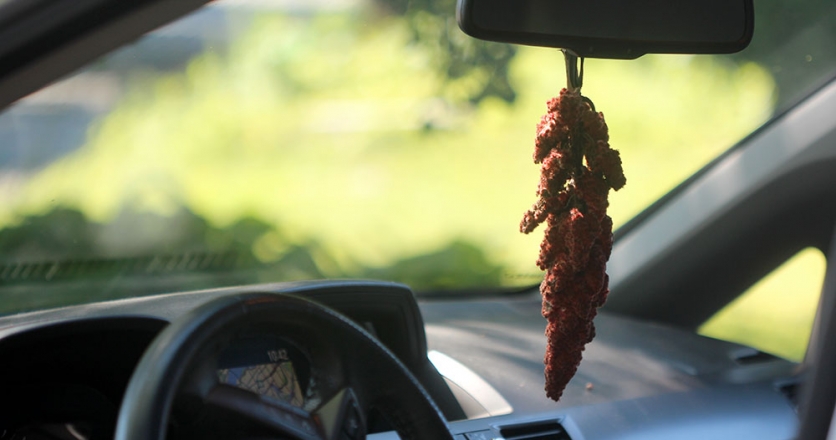Roadside Spice
If you’ve driven around Ottawa with your eyes open, you’ve seen sumac. The small gnarly shrubs with feathery canopies of toothy leaves and bright-red berry clusters, which ripen from late summer to early fall, add their own special aesthetic to our roadsides.
Odds are you’ve even eaten sumac before. The only way you haven’t is if you happen to be that one outlier who’s never stepped foot into one of our many Middle Eastern restaurants. Sumac is the dark red powder, which finds its way onto nearly every plate, giving it a hint of beautifully perfumed tartness. It functions the same way a squirt of lemon would to finish off a dish. Shawarma, fattoush, hummus, kebabs and the rest of the items on the menu often get mixed up with this wonderful spice either on its own or as part of Za’atar — a herb and spice blend of sumac, thyme and sesame seeds.
And yet it doesn't seem as though anyone’s parking on the side of highway to pick sumac for their restaurant. The sumac available in the spice aisle is not our native staghorn sumac — Rhus typhina — but rather Rhus coriaria, which is native to Southern Europe, the Caucasus, the Middle East and parts of Northern Africa. That doesn’t mean that you can’t use staghorn sumac as a local substitute though you may want to find a source that isn’t constantly drinking up the exhaust of our daily commutes.
Harvesting: Rain is for mushrooms; sunshine is for flowers
When you find the perfect sumac patch, try to plan your harvest to avoid rain. As with most flowers, the perfume is most potent in hot, dry weather and tends to get washed out by rain.
And if you’re wondering if the little hairy berries are ripe, give them a taste. If the tartness of the berries makes your face pucker like a baby’s first taste of lemon — you’re good to go. Just clip the clusters and make your way to the kitchen.
Wet: The easy preparation
The easiest thing to do with fresh sumac berries is to crush them with a mortar and pestle, add water and let them soak before straining through cheesecloth or a fine-mesh sieve. How much water and how long should it soak? It all depends on what you want to do with it.
If there was such a thing as a mainstream recipe for fresh sumac berries, it would be sumac-ade or wild pink lemonade. Just don’t call it roadside weed juice — no one will drink it.
Like lemonade, all you have to do to make sumac-ade is dilute sumac juice with water and add boatloads of sugar or honey. Alhough you could find recipes for exact quantities, it really depends on taste. If your palate prefers sweet to sour, one sumac cluster per one-litre jug of juice does the trick. Add ice, sweeten to taste and enjoy. If some rum and mint happen to fall in, call it a mojito. After all, you're an adult.
Following the same logic, if your water to berry ratio is lower, you’ll have a more concentrated juice. Use this concentrated juice anywhere you’d use citrus — drizzled on freshly grilled fish, mixed with oil in your next vinaigrette or added to salsa fresca. There are no rules.
Dry: the slightly less easy preparation
So you’ve tasted sumac-ade and convinced everyone in your house to drizzle sumac juice on the freshly caught walleye instead of lemon juice. Heck, you even went so far as to use it to make a ceviche of brook trout, radishes, cucumber, Serrano chile and pickled white onions. But sumac season is almost over and you just can’t kick the habit. Fret not. There is an easy solution.
To dry herbs, you simply tie them up, hang them somewhere warm and breezy and you'll have dried herbs all winter long, but sumac berries are heftier, requiring proper dehydration. You could separate the berries from the cluster and pop them into an electric dehydrator. But let’s say you don’t have an electric dehydrator. There is a good chance you have a car and the late summer sun on your side. Put these two together and, lo and behold, you have yourself a solar dehydrator.
Granted, everyone will think you’re weird for using your car as a solar dehydrator, but everyone knows how hot it can get in there. Turns out, it’s kind of perfect for dehydrating all manner of food products. Fat stalks of rhubarb dehydrated on a car dash can and has been done, so put your inhibitions aside. On a sunny day, hang your sumac clusters in your car or separate the berries and place them on paper towels on your dash. Next thing you know, they’ll be as dry as your mother-in-law’s Thanksgiving turkey.
The final step is to rub the dried berries in a fine-meshed sieve until all you have left are the seeds which can be bitter, so best left out. What you’ll have is a dark red powder perfect for adding a bit of zing to your dishes. If it happens to be a Middle Eastern dish, great; if not, add it anyway.






